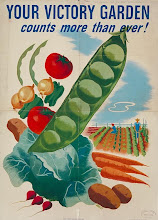Our local foods group is hosting a fundraising Gala this Saturday night. Local wines, cheeses, appetizers and music, all good things. In a moment of weakness I volunteered to make soap for the silent auction. I shouldn't say it was weakness as such, only I've had so little free time and even less energy to do extra projects this past month. Also, it's been two years since I've made a batch of soap. I was afraid I would be a bit rusty.
Because of the short turn-around time I had to use the hot process method. The soap made with the hot process method can be used immediately, whereas cold process soap needs to cure for a few weeks. Both methods have their pros and cons, but I am considerably more accustomed to cold processed.
Fortunately, I had a supply of lye on hand, ordered this past spring. It has been my experience that over time lye (especially the stuff stored in plastic bags) will absorb moisture from the air and lose its potency. A good sign that your lye is bad is caking. If you open your lye container and instead of seeing fine crystals you see caked clumps, throw it out. This is the reason why I always order lye in cans, not bags. I pay a bit more for it that way, but it lasts a lot longer.
I had also ordered some new oils. Here's a five-gallon pail of coconut oil. Coconut oil adds lather to the soap. Every oil has its own particular properties that will affect the final bars.
Because this is a local foods event, I wanted to make the soap as local as possible. So I rummages around in my freezer and found a few old bags of rendered tallow. Tallow helps your soap harden nicely, and last longer.
First you create your soap 'recipe.' Then you gather your equipment, measure out your oils and lye, and combine them together. Lots of stirring is involved (thank heaven for stick blenders). Here is the soap mixture at heavy trace after the lye and oils have been combined and stirred well together. You can see the pudding-like consistency. With cold process soap, at this point you would pour the mixture into your mold and let it saponify (the chemical reaction that changes the oils and lye into soap) as it cured. With hot process soap, you speed up the reaction with heat. I cooked it in a double boiler on the stove top, but it can also be done in an oven or even a crock pot.

After it cooks, after most of the liquid has disappeared and saponification is nearly complete, it turns to a gel consistency. This is when you put the additives in, such as colorants, scents or botanicals. I made two different kinds last night: a lavender lime (lavender buds and lime essential oil) and a peppermint (with peppermint essential oil and powdered beet root). I was experimenting with the beet root, to see if it would turn the soap a nice red color. It did not. Instead, I just got brownish flecks. Oh well, live and learn.
After you put your additives in, you pour it into the molds. I use plastic drawers from those cheap storage cabinets you can buy at Target. Let the soap sit for several hours, til it is completely hardened.
Pop it carefully out of the mold, and score it for cutting. I decided to make large rectangular bars. I like the look of the larger brick size. They remind me of soap made back in ye olden days.
One four-pound batch made ten large bars, each averaging six ounces. The bars will shrink a little over time as more water evaporates out. The extra bits that I trimmed off the edges will be used in our house. Homemade soap is just too nice to be wasted.
And voila! The final product. This is one of the peppermint bars--you can see what I mean about the beet root speckles. It's not unattractive, it's just not what I was going for.
I think that's what I like most about soap making: the experimentation. The art. You can choose your oils, your colors, your shapes, your scents, everything. I don't really do 'art' as most people understand it. No painting, drawing, sculpture, photography, etc. Unless you count this blog thing as art, which some people may.
The science behind soap making also appeals to me. Figuring out oil to lye ratios, writing a recipe, following precise procedures. Also, as anyone who has ever used homemade soap will testify, the bars in themselves are fabulous. Creamy, rich and sudsy--and they won't dry your skin like commercial detergent bars.
I had forgotten how much I enjoy making the stuff. Now I've got the itch to make more. I'm thinking something with chamomile next time...
P.S. If you're interested in making soap, I recommend the 'The Handmade Soap Book' by Melinda Coss. It's got good info on ingredients and has some really nice recipes. It focuses, like most soap making books, on the cold process. And it's got a handy saponification chart. The book is a little lacking in its description of the soap-making procedure itself, but there's lots of info about that to be found on the internet.


















































